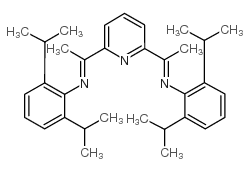204203-14-5
| 中文名 | 2,6-双[1-(2,6-二异丙苯亚氨基)乙基]吡啶 |
|---|---|
| 英文名 | N-[2,6-di(propan-2-yl)phenyl]-1-[6-[N-[2,6-di(propan-2-yl)phenyl]-C-methylcarbonimidoyl]pyridin-2-yl]ethanimine |
| 英文别名 |
N-(2,6-diisopropylphenyl)-N-((1E)-1-(6-[(1E)-N-(2,6-diisopropylphenyl)ethanimidoyl]pyridin-2-yl)ethylidene)amine
2,5,6-TRIMETHYL[1,3]THIAZOLO[4,5-B]PYRAZINE 2,6-BIS[1-(2,6-DI-I-PROPYLPHENYLIMINO)ETHYL]PYRIDINE 2,6-bis[1-(2,6-diisopropylphenylimino)ethyl]pyridine (C5H3N)(MeC=N(C6H4-2,6-iPr2))2 2,6-{(dipp)NC(CH3)}2C5H3N |
| 密度 | 0.99g/cm3 |
|---|---|
| 沸点 | 573.6ºC at 760 mmHg |
| 分子式 | C33H43N3 |
| 分子量 | 481.71500 |
| 闪点 | 300.7ºC |
| 精确质量 | 481.34600 |
| PSA | 37.61000 |
| LogP | 9.85660 |
| 外观性状 | Powder | pale yellow |
| 蒸汽压 | 1.44E-12mmHg at 25°C |
| 折射率 | 1.551 |
| 储存条件 | 2-8°C |
| 计算化学 | 1.疏水参数计算参考值(XlogP):无 2.氢键供体数量:2 3.氢键受体数量:2 4.可旋转化学键数量:2 5.互变异构体数量:3 6.拓扑分子极性表面积50.4 7.重原子数量:14 8.表面电荷:0 9.复杂度:201 10.同位素原子数量:0 11.确定原子立构中心数量:0 12.不确定原子立构中心数量:0 13.确定化学键立构中心数量:0 14.不确定化学键立构中心数量:0 15.共价键单元数量:1 |
|
Section 1: Product Identification Chemical Name:2,6-Bis[1-(2,6-di-i-propylphenylimino)ethyl]pyridine, 98% CAS Registry Number:204203-14-5 Formula:C33H43N3 EINECS Number:none Chemical Family:organic amine Synonym:none
Section 2: Composition and Information on Ingredients IngredientCAS NumberPercentACGIH (TWA)OSHA (PEL) Title compound204203-14-5100%no datano data Section 3: Hazards Identification Emergency Overview:No particular hazard associated with this material. Primary Routes of Exposure:Ingestion, inhalation Eye Contact:May cause slight to mild irritation of the eyes Skin Contact:May cause slight to mild irritation of the skin. Inhalation:May be irritating to the nose, mucous membranes and respiratory tract. No specific information is available on the physiological effects of ingestion. May cause vomiting and diarrhea. Ingestion: Acute Health Affects:May be irritating to skin, eyes and respiratory tract. Chronic Health Affects:No information available on long-term chronic effects. NTP:No IARC:No OSHA:No SECTION 4: First Aid Measures Immediately flush the eyes with copious amounts of water for at least 10-15 minutes. A victim may need Eye Exposure: assistance in keeping their eye lids open. Get immediate medical attention. Wash the affected area with water. Remove contaminated clothes if necessary. Seek medical assistance if Skin Exposure: irritation persists. Remove the victim to fresh air. Closely monitor the victim for signs of respiratory problems, such as difficulty Inhalation: in breathing, coughing, wheezing, or pain. In such cases seek immediate medical assistance. Seek medical attention immediately. Keep the victim calm. Give the victim water (only if conscious). Induce Ingestion: vomiting only if directed by medical personnel. SECTION 5: Fire Fighting Measures Flash Point:none Autoignition Temperature:none Explosion Limits:none Extinguishing Medium:carbon dioxide, dry powder or foam Fire fighters should be equipped with a NIOSH approved positive pressure self-contained breathing apparatus Special Fire Fighting Procedures: and full protective clothing. Hazardous Combustion andIf involved in a fire this material may emit toxic organic fumes. Decomposion Products: Unusual Fire or Explosion Hazards: No unusual fire or explosion hazards. SECTION 6: Accidental Release Measures Spill and Leak Procedures:Small spills can be mixed with vermiculite or sodium carbonate and swept up. SECTION 7: Handling and Storage Handling and Storage:Store in a tightly sealed container. Keep away from heat and direct sunlight. SECTION 8: Exposure Controls and Personal Protection Eye Protection:Always wear approved safety glasses when handling a chemical substance in the laboratory. Skin Protection:Wear protective clothing and gloves. Ventilation:Material may form a fine dust. If possible, handle the material in an efficient fume hood. If ventilation is not available a respirator should be worn. The use of respirators requires a Respirator Respirator: Protection Program to be in compliance with 29 CFR 1910.134. Ventilation:Material may form a fine dust. If possible, handle the material in an efficient fume hood. Additional Protection:No additional protection required. SECTION 9: Physical and Chemical Properties Color and Form:pale yellow powder Molecular Weight:481.69 Melting Point:no data Boiling Point:no data Vapor Pressure:no data Specific Gravity:no data Odor:none Solubility in Water:slightly soluble SECTION 10: Stability and Reactivity Stability:air and moisture-stable solid Hazardous Polymerization:none Conditions to Avoid:none Incompatibility:strong oxidizing agents Decomposition Products:carbon dioxide, carbon monoxide, nitrogen oxides, and organic fumes. SECTION 11: Toxicological Information RTECS Data:No specific information available on this product. Carcinogenic Effects:No data available Mutagenic Effects:No data available Tetratogenic Effects:No data available SECTION 12: Ecological Information Ecological Information:No information available SECTION 13: Disposal Considerations Disposal:Dispose of according to local, state and federal regulations. SECTION 14: Transportation Shipping Name (CFR):Non-hazardous Hazard Class (CFR):NA Additional Hazard Class (CFR):NA Packaging Group (CFR):NA UN ID Number (CFR):NA Shipping Name (IATA):Non-hazardous Hazard Class (IATA):NA Additional Hazard Class (IATA):NA Packaging Group (IATA):NA UN ID Number (IATA):NA SECTION 15: Regulatory Information TSCA:not listed on the TSCA inventory SARA (Title 313):not regulated by Title 313 Second Ingredient:none SECTION 16 - ADDITIONAL INFORMATION N/A |
| 风险声明 (欧洲) | R36/37/38 |
|---|---|
| 安全声明 (欧洲) | S26-S36-S37-S39 |
|
~86% 
204203-14-5 |
| 文献:Wang, Xin; Yang, Yulin; Fan, Ruiqing; Jiang, Zhaohua New Journal of Chemistry, 2010 , vol. 34, # 11 p. 2599 - 2604 |
|
~% 
204203-14-5 |
| 文献:MOMENTIVE PERFORMANCE MATERIALS INC.; CORNELL UNIVERSITY Patent: WO2011/6044 A2, 2011 ; |
|
~% 
204203-14-5 |
| 文献:Calderazzo, Fausto; Englert, Ulli; Pampaloni, Guido; Santi, Roberto; Sommazzi, Anna; Zinna, Marianna Dalton Transactions, 2005 , # 5 p. 914 - 922 |







